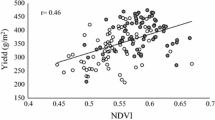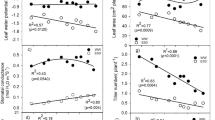Abstract
Large areas of wheat (Triticum aestivum L. Fion et Paol.) are grown under above-optimal temperatures causing significant yield reductions. Adaptation of wheat to such areas through genetic improvement is a way of increasing production in those regions. To identify new and novel sources of heat tolerance, 2,255 Mexican wheat landraces, grown for seed regeneration under semi-controlled conditions in the screenhouse, were evaluated for leaf chlorophyll content (LCC). The landraces were collected from areas with seasonal high temperatures. Based on these initial results, two subgroups of 127 landraces each were selected, one with high LCC values and one with low LCC values. During 1997 the selected subgroups were grown in the screenhouse and in field trials in Cd. Obregon, Mexico. The landraces were evaluated for traits associated with heat tolerance: LCC, canopy temperature depression, and thousand-kernel weight (KWT). The objectives of the study were to identify new sources of heat tolerance and to assess the feasibility of combining basic seed regeneration with characterization for needed traits like heat tolerance. A highly significant correlation was found between LCC in the screenhouse and in field trials, indicating the promise of using a screenhouse for cost effective evaluation of heat tolerance traits. This strategy could be used to identify regions or groups of germplasm that merit more intense screening. Highly significant correlations were also found between LCC and KWT. Three landrace cultivars with superior and consistent LCC values were identified. These accessions are potentially useful sources for improving heat tolerance in cultivated wheat.
Similar content being viewed by others
References
Al-Khatib, K. & G.M. Paulsen, 1984. Mode of high temperature injury to wheat during grain development. Plant Physiol. 61: 363–368.
Amani, I., R.A. Fischer & M.P. Reynolds, 1996. Canopy temperature depression association with yield of irrigated spring wheat cultivars in a hot climate. J. Agronomy & Crop Science. 176: 119–129.
Curtis, B.C., 1988. Keynote address: The potential for expanding wheat production in marginal and tropical environments. In: Klatt, A.R. (Ed.), Wheat Production Constraints in Tropical Environments, pp. 3–11, Mexico, D.F.: CIMMYT.
Fischer, R.A. & D.R. Byerlee, 1991. Trends of wheat production in the warmer areas: Major issues and economic considerations. In: Saunders, D.A. (Ed), Wheat for the Non-traditional Warm Areas, pp. 3–27, Mexico, D.F.: CIMMYT.
John, J.A. & J.A. Eccleston, 1986. Row-column alpha-designs. Biometrika 73: 301–306.
Ortiz-Ferrara, G., S. Rajaram & M.G. Mosaad, 1994. Breeding strategies for improving wheat in heat-stressed environments. In: Saunders, D.A. & G.P. Hettel (Eds.), Wheat in Heat-stressed Environments: Irrigated dry areas and rice-wheat farming systems, pp. 24–32, Mexico, D.F.: CIMMYT.
Patterson, H.D., & D.L. Robinson, 1989. Row-column designs with two replicates. Journal of Agricultural Science, Cambridge. 112: 73–77.
Reynolds, M.P., M. Balota, M.I.B. Delgado, I. Amani & R.A. Fischer, 1994. Physiological and morphological traits associated with spring wheat yield under hot, irrigated conditions. Aust. J. Plant Physiol. 21: 717–730.
Reynolds, M.P., R.P. Singh, A. Ibrahim, O.A.A. Ageeb, A. Larque-Saavedra & J.S. Quick, 1998. Evaluating the physiological traits to complement empirical selection for wheat in warm environments. Euphytica 100: 85–94.
Rosegrant, M.W., M.A. Sombilla, R.V. Gerpacio & C. Ringler, 1997. Global food markets and US exports in the twenty-first century. Paper prepared for the Illinois World Food and Sustainable Agriculture Program Conference ‘Meeting the Demand for Food in the 21st Century: Challenges and Opportunities for Illinois Agriculture', May 27, 1997.
Skovmand, B., P.N. Fox, G. Varughese & D. Gonzalez-de-Leon, 1995. International activities in wheat germplasm: CIMMYT's perspective. In: Duncan, R.R. (Ed.), International Germplasm Transfer: Past and Present, pp. 135–148, CSSA Special Publication Number 23. American Society of Agronomy, Inc., Soil Science Society of America, Inc., Madison, Wisconsin, USA.
Wardlaw, J.F., I. Sofield & P.M. Cartwright, 1980. Factors limiting the rate of dry matter accumulation in the grain of wheat grown at high temperature. Aust. J. Plant Physiol. 7: 387–400.
Yates, F., 1937. A further note on the arrangement of variety trials: Quasi-Latin squares. Annals of Eugenics 7: 121–140.
Author information
Authors and Affiliations
Rights and permissions
About this article
Cite this article
Hede, A., Skovmand, B., Reynolds, M. et al. Evaluating genetic diversity for heat tolerance traits in Mexican wheat landraces. Genetic Resources and Crop Evolution 46, 37–45 (1999). https://doi.org/10.1023/A:1008684615643
Issue Date:
DOI: https://doi.org/10.1023/A:1008684615643




